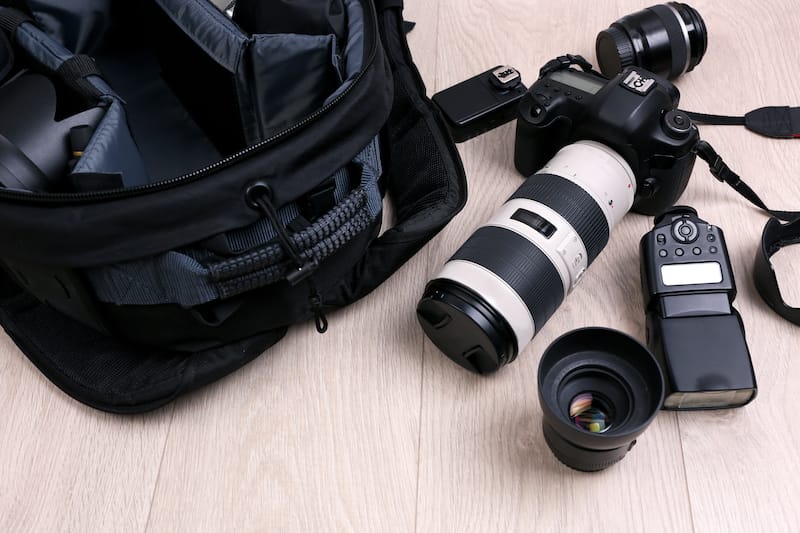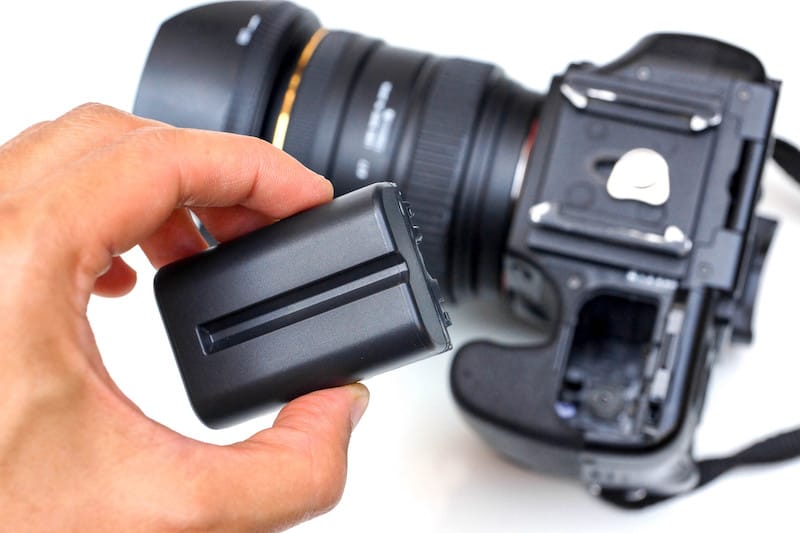Just because you’ve taken hundreds of photographs doesn’t mean you have years of experience. In fact, many professional photographers still make some of the same mistakes after so many years.
Why? Why do professional photographers still make the same mistakes after so many years in the game? It’s simple, they just don’t know better.
They have been doing everything a certain way for so long that they don’t learn from their mistakes. It’s time we help them by sharing this list of mistakes with them.
In this post...
- Not doing preventative maintenance on your gear
- Not having insurance for your camera gear
- Not getting out of your comfort zone
- Not using social media properly to market your photography business
- Not checking your batteries before a shoot
- Not backing up your work
- Not shooting in RAW format
- Forgetting to utilize props
- Forgetting to readjust your settings for different parts of a photoshoot
- In Conclusion
Not doing preventative maintenance on your gear
Make sure you’re taking precautions to minimize dust, dirt, and moisture getting into your camera. If your lens does get dirty, take the cap off and use a blower before attempting any kind of cleaning.
When cleaning your camera or lens, it’s best to use either a microfiber cloth or a soft cotton cloth that won’t leave any fibers behind on the surface of the glass.
You don’t want to be putting pressure on the glass when wiping it down—just let gravity do its job for you. Avoid using tissues as they can scratch up delicate surfaces.
If you find yourself shooting in hot conditions or dusty areas often, then consider investing in some kind of airtight casing for your equipment so that it doesn’t get damaged while not in use. The last thing you want is to have a malfunctioning camera during an important shoot!
Not having insurance for your camera gear
Your camera gear is expensive to replace. You know how you heard from a friend of a friend a story about how their cousin’s roommate’s brother-in-law dropped his camera, and it cracked? Well, that could happen to you at any time.
What if someone steals your gear? What if lightning strikes your house and destroys everything in the house including your gear?
All of those things are possible. Nobody expects them to happen, but if they do, you could be out thousands of dollars worth of gear. And the sad thing is that for not much more than the price of a fancy cup of coffee per month, you can avoid all that risk with insurance.
Insuring your camera is a good investment that will keep your business running when disaster strikes.
Not getting out of your comfort zone
If you’re looking to become an even more creative photographer and explore new styles, then it’s time for you to step out of your comfort zone. Your comfort zone is where the magic happens, and it’s the place in which you will grow.
The easiest way to break free from your comfort zone is by doing something that scares you. Well, scared may be a strong word, but some things may be uncomfortable or uneasy at first. If you want to try shooting landscapes in the snow or go hiking, go do it!
If you want to try photographing people, start walking around your neighborhood and introduce yourself! You can also try a photography project like A Photo A Day or 365 Project to help break through some of those barriers as well.
There are many ways in which you can take the next step toward getting out of your comfort zone. What do you fear? Is there something that causes anxiety? Try it! Yes, we know that can sound quite silly and easier said than done, but it will get easier every time.
Being a professional photographer means more than just taking beautiful photos—you also have to market your business. Social media has become an integral part of photographers’ marketing strategies.
It’s the quickest and easiest way to promote your work, connect with clients, build your brand, and network with other photographers.
Not every social media platform will be right for you or your photography business, so choose wisely. Have a look at what other photographers in similar fields are doing and see what’s working for them.
Knowing who your target audience is will help you decide which platforms to use (for example, Instagram is very popular with wedding photographers).
The key is to be consistent across all of your social media platforms. Keep the tone and feel of all of them relatively uniform so that when people look at one, they know exactly where else to find you online without having to guess or do a lot of searching.
Not checking your batteries before a shoot
Nothing is more embarrassing than turning up for a shoot, only to find that your camera doesn’t turn on. Even if you just checked it the day before, check it again before you go out to shoot.
Batteries can suddenly lose charge or develop problems and don’t last forever (500-2,000 full charges depending on the type of battery).
Always have a spare battery with you and make sure they are fully charged before heading out.
If you have spare batteries in storage, check them regularly and recharge any that drop below 50% charge. If they discharge to zero or go flat they will be damaged and will not last as long.
You should always use the charger supplied with your camera because some chargers can damage batteries by giving them too high a voltage.
Never leave batteries charging overnight. Newer batteries will stop charging when full and older types will be damaged by overcharging.
Not backing up your work
Something you don’t want to happen is losing your work due to an unfortunate event, like a hard drive failure or a tech-savvy raccoon. It will take you much longer to recover and get back on track than it would have if you had just backed up!
Luckily there are many options for backing up your work depending on your budget, convenience, and preference. You can backup on Compact Flash cards (CF), SD cards, external HDDs, Solid State Drives (SSDs), cloud storage, or a combination of them all.
I personally have a 2TB HDD and use cloud storage in case something happens to my physical drives.
When should you backup? Whenever you’re about to put in significant time editing an image or a collection of images that are similar in terms of processing style…essentially anytime when you feel like “this is the last time I’ll be working on this” from an editing standpoint.
You can also set up backups automatically every night at midnight with 3rd party apps like Lightroom Classic CC Sync Settings.
The frequency with which you should backup depends on how often you shoot … but as a rule of thumb I recommend doing so no more than once every week or so if you’re shooting daily/multiple times per day.
If you ever go on vacation for several weeks and won’t be shooting during that time then it’s okay to skip the backups during that vacation period unless anything catastrophic happens while away!
Not shooting in RAW format
You can take a lot of control over the final outcome of your photographs if you shoot in RAW format. You’re basically giving yourself high-resolution, film-like negatives from which you can make prints.
If you want to create black and white images, for example, or if you want to change the color tone of your pics, shooting in RAW will give you more latitude than JPEGs would allow.
Plus, it’s a totally different experience when looking at a picture in its original state vs. an image that has already been manipulated by the camera.
Forgetting to utilize props
Photography props can add interest to your photos, making them really pop. In order to know how to choose and utilize photography props, however, you first need to understand what type of prop will work best with your subject.
As a general rule, the following two things should be considered prior to select a prop:
- Will the material I’ve chosen for my props complement or distract from the subject of my photo?
- Is there a special theme or concept I want to be featured in my photos?
Once you’ve considered these questions and chosen your props accordingly, you can use them in any of the following ways:
- Use a prop that complements your subject to add additional interest by posing it naturally with (or on) your model.
- Try framing your photo in an unusual way by having someone hold up one side of a large piece of fabric as if it were an actual frame for the photo.
- Use one or more props strategically around the setting of your photoshoot so that they blend into the background but help tell a story about what is happening in the photo.
Forgetting to readjust your settings for different parts of a photoshoot
Aside from their mental mistakes, professional photographers also make technical mistakes. All the time. They often forget to readjust their camera settings when going from one place to another or one subject to another.
Here are some examples of times you might need to readjust your camera settings:
- If you’re shooting indoors, and then move outside (or vice-versa).
- If you’re using a flash and then take it off or put it away (or vice versa).
- If you’re shooting in direct sunlight and then move into the shade (or vice versa).
- If you’re shooting a close-up and then zoom out for a wide-angle shot (or vice versa).
In Conclusion
You’ve probably heard or seen the phrase, “Experience is the best teacher”. While it’s true, sometimes even experienced photographers fall into the same traps over and over again.
It goes to show that everyone has room for improvement, no matter how long you’ve been in the industry.
Don’t get us wrong — experts do have an advantage over beginners when it comes to their experience and knowledge base. But there are also a lot of mistakes that even pros make on a regular basis. We hope this blog takes your photography to another level.

Megan is a travel blogger and writer with a background in digital marketing. Originally from Richmond, VA, she now splits her time between Frankfurt, Germany and Arctic Finland after also living in Norway, Armenia, and Kazakhstan. She has a passion for winter travel, as well as the Nordic countries, but you can also find her eating her way through Italy, perusing perfume stores in Paris, or taking road trips through the USA. Megan has written for or been featured by National Geographic, Forbes, Lonely Planet, the New York Times, and more. She co-authored Fodor’s Travel ‘Essential Norway’ and has visited 45 US states and 100+ countries.



